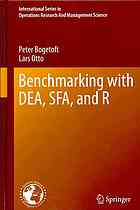

Most ebook files are in PDF format, so you can easily read them using various software such as Foxit Reader or directly on the Google Chrome browser.
Some ebook files are released by publishers in other formats such as .awz, .mobi, .epub, .fb2, etc. You may need to install specific software to read these formats on mobile/PC, such as Calibre.
Please read the tutorial at this link: https://ebookbell.com/faq
We offer FREE conversion to the popular formats you request; however, this may take some time. Therefore, right after payment, please email us, and we will try to provide the service as quickly as possible.
For some exceptional file formats or broken links (if any), please refrain from opening any disputes. Instead, email us first, and we will try to assist within a maximum of 6 hours.
EbookBell Team

4.4
72 reviewsThis book covers recent advances in efficiency evaluations, most notably Data Envelopment Analysis (DEA) and Stochastic Frontier Analysis (SFA) methods. It introduces the underlying theories, shows how to make the relevant calculations and discusses applications. The aim is to make the reader aware of the pros and cons of the different methods and to show how to use these methods in both standard and non-standard cases.
Several software packages have been developed to solve some of the most common DEA and SFA models. This book relies on R, a free, open source software environment for statistical computing and graphics. This enables the reader to solve not only standard problems, but also many other problem variants. Using R, one can focus on understanding the context and developing a good model. One is not restricted to predefined model variants and to a one-size-fits-all approach. To facilitate the use of R, the authors have developed an R package called Benchmarking, which implements the main methods within both DEA and SFA.
The book uses mathematical formulations of models and assumptions, but it de-emphasizes the formal proofs - in part by placing them in appendices -- or by referring to the original sources. Moreover, the book emphasizes the usage of the theories and the interpretations of the mathematical formulations. It includes a series of small examples, graphical illustrations, simple extensions and questions to think about. Also, it combines the formal models with less formal economic and organizational thinking. Last but not least it discusses some larger applications with significant practical impacts, including the design of benchmarking-based regulations of energy companies in different European countries, and the development of merger control programs for competition authorities.